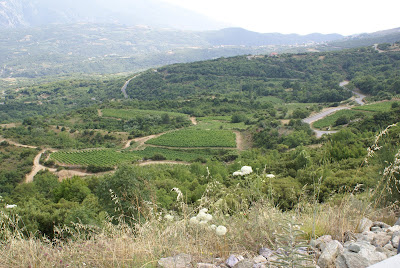



From top to bottom: Katsaros vineyards on Mount Olympus, early course at a wine dinner at the Katsaros home, afternoon party time at a taverna in Epanomi (don't step on the broken crockery), and Gerovassiliou vineyards rolling like waves toward the Aegean.
It seems only proper that I started a week of drinking Greek wine - accompanied by platefuls of delicious Greek foods - on the umbrella-covered deck of a bare-bones kantina at the edge of the Aegean and ended it in the lair of the Gods on the heights of Mount Olympus.
With some magazine and web assignments to write about Greek wines in my jacket pocket, I arrived at the beginning of the week in Thessaloniki, Greece's second largest city and the capital of Macedonia, wedged between the ocean and the foothills that extend into the nearby Balkans. Most of the next four days I spent exploring three connected, yet diverse wineries and their cultural environs - Domaine Gerovassiliou, whose vineyards are just a few feet above sea level in nearby Epanomi, Biblia Chora, northeast of the city on the way to Kavala, and Katsaros Estate, high above the village of Krania on one of the many slopes of the sprawling Olympus.
While I won't review all the individual wines tasted during the trip - and almost all of which are available in Canada and New York City - a few observations can be made:
1. Although Greek white wines have received most of the attention in these discovery years since the Olympics, the reds are just as good and certainly capable of long cellar aging.
2. The most-popular indigenous grapes, both white and black, from the best producers could easily be mistaken in blind tastings for some of the international varietals - a plus if you're looking for acceptance, a minus if you're looking for sharp differentiation.
3. International varieties grow well in Greece, and there is an understandable temptation to mix them with Greek grapes - sometimes in the minority cuvee - to form Super Greek blends.
4. Where a grape still planted matters, which comes as no surprise, so a Malagousia grape planted in Macedonia (the locals pronounce it with a hard "c" - "Mackadonia") will yield different wine than grapes planted on one of the islands.
5. The names aren't as hard to learn and pronounce as you might think: Can you say Malagousia, Assyrtico, Xinomavro and Roditis? Sure you can! OK, Agiorghitiko might take some tutoring.
Although I have tasted many wines from Greece before, this was the first time I tasted them at the source along with the local cuisine in all of its various venue - from a kantina on the beach to a taverna to a fine restaurant in downtown Thessalonika to the homes of winemakers' wives Sonia Gerovassiliou and cookbook author Stella Katsaros. It was also the first time I had an opportunity to taste so many Greek wines of high quality on continuous days, rather than a couple of good ones here and a couple of iffy ones there. It does make a positive difference in the overall perception.
As the articles are written and printed in the weeks and months ahead, I will post them or their links to this site. In the meantime, ask your sommelier or wine merchant for recommendations for some good Greek whites you can chill out with over the midsummer holiday.
Until next time...
Roger Morris


No comments:
Post a Comment